Wild n’ Crazy Saint Estèphe 2018?
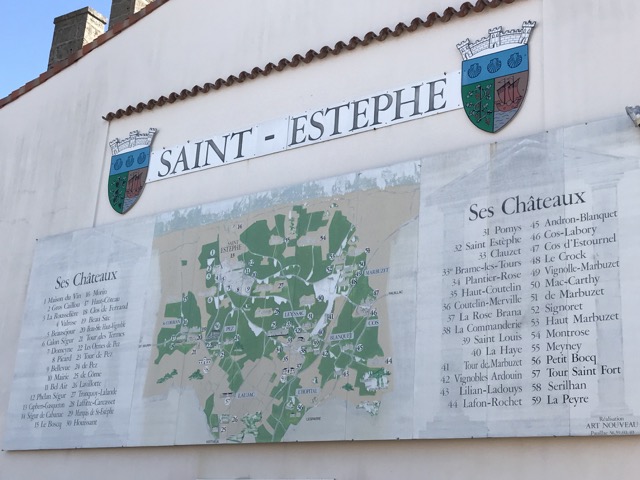
By Panos Kakaviatos for wine-chronicles.com
26 April 2019
Saint Estèphe is an appellation that tends to thrive in hot and arid summers. Take for examples the torrid heat of the 2003 vintage. The cooler soils underneath gravel in Saint Estèphe seemed to counter the extreme weather better than any other Bordeaux appellation of note. Many tasters would agree just how well Château Montrose, for example, handled that vintage. Such was also the case in 2009, although 2009 is (far) more balanced than 2003. And such is the case again, in 2018.
On the other hand, in 2018, I have never seen such high alcohol levels from some of these wines, along with quite low acidities, yet high tannin levels.
Some are pointing out that the density of ripe fruit is just fine, that the dry extract of the wines will make them just fine for long term aging. More important – oenologist Thomas Duclos points out – the aromatic freshness is there. But I have heard enough over the years that high levels of pH combined with high alcohol is not necessarily ideal. After all, Bordeaux wants to sell you these wines! At issue here is the type of balance. Do you want a balanced wine at near 15% alcohol, or a balanced wine at near 13% alcohol. Should it matter? These are the questions I ponder late at night whilst sipping on 43% alcohol single malt.
In any case, I am using a wider range of scores for some of these preliminary barrel assessments. Nevertheless, all wines below are at least red and bold on my informal color coordinated in bold or not rating scale. As you can recall, wines I like in particular are in bold, even more in red and bold, and if underlined, too, a potential wine nirvana.
What makes this vintage – again as expressed in my introduction for “hedonists and intellectuals” – is how Saint Estèphe’s so-called Super Seconds handled 2018.
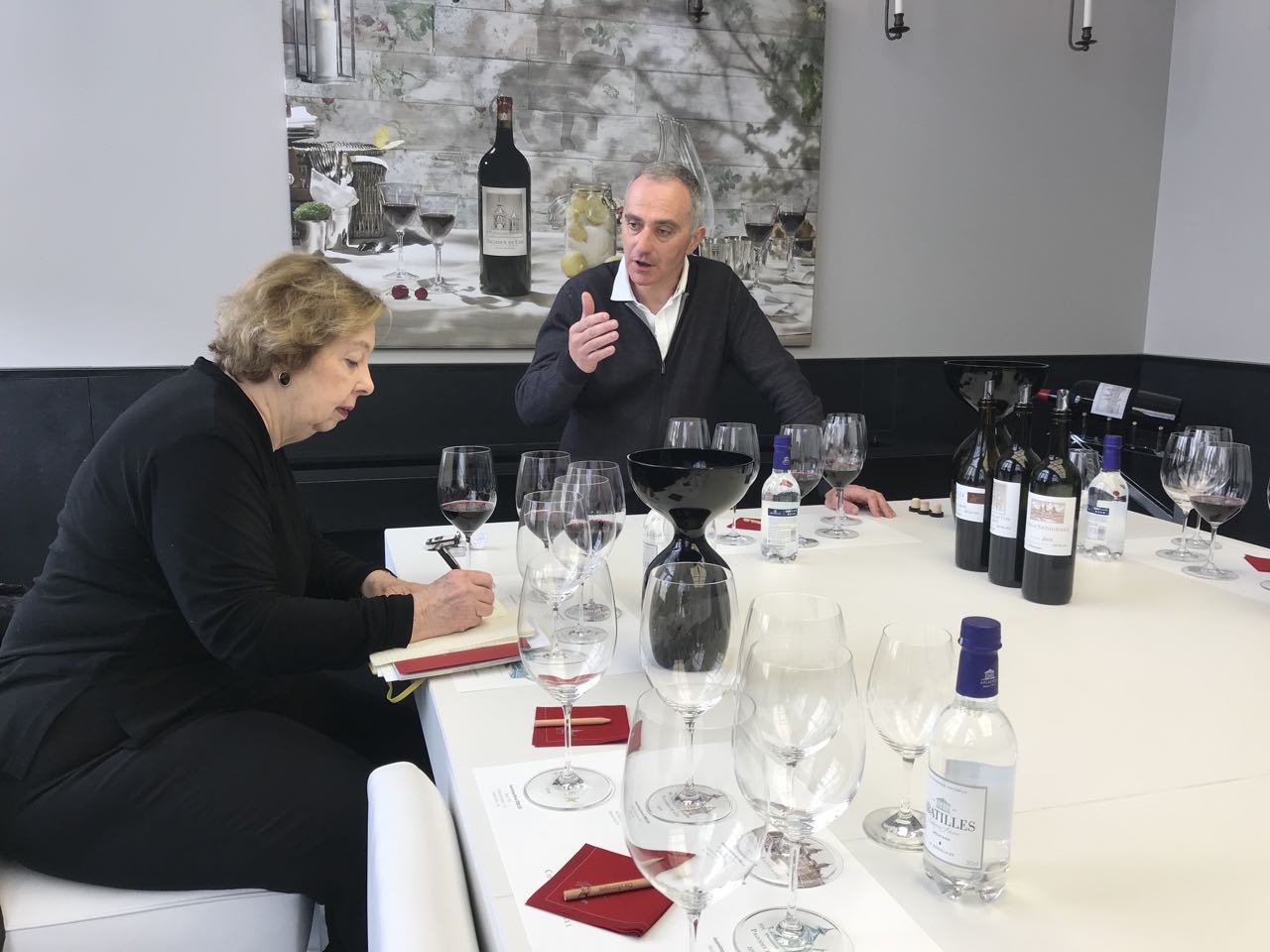
“We are using less new oak this year,” remarks Dominique Arangoits of Château Cos d’Estournel, as Bloomberg wine writer and author Elin McCoy takes notes.
On one level, Château Cos d’Estournel, the famous estate known for its Indian style pagoda architecture, tried to make the vintage as “classical” as possible. Indeed, the aging will be done with less new oak, so as to avoid the high alcohol wine (14.4%) from leaching too much new oak tannin, as there is already quite enough from the grapes themselves (the tannic index is about 80 at Cos). Also, the blend includes more grapes from vines grown on the deeper clay soils of the estate than usual, so as to maintain as much freshness as possible, remarked technical director Dominique Arangoits. On another level, Château Montrose seemed more to “embrace” the vintage’s extraordinary characteristics.
Now, I did not taste as many of the copious cru bourgeois level wines that make this appellation so famous, but the above leave me with enough of the impression to have a tongue-in-cheek subtitle, “wild and crazy”, at least for Montrose and Calon Ségur.
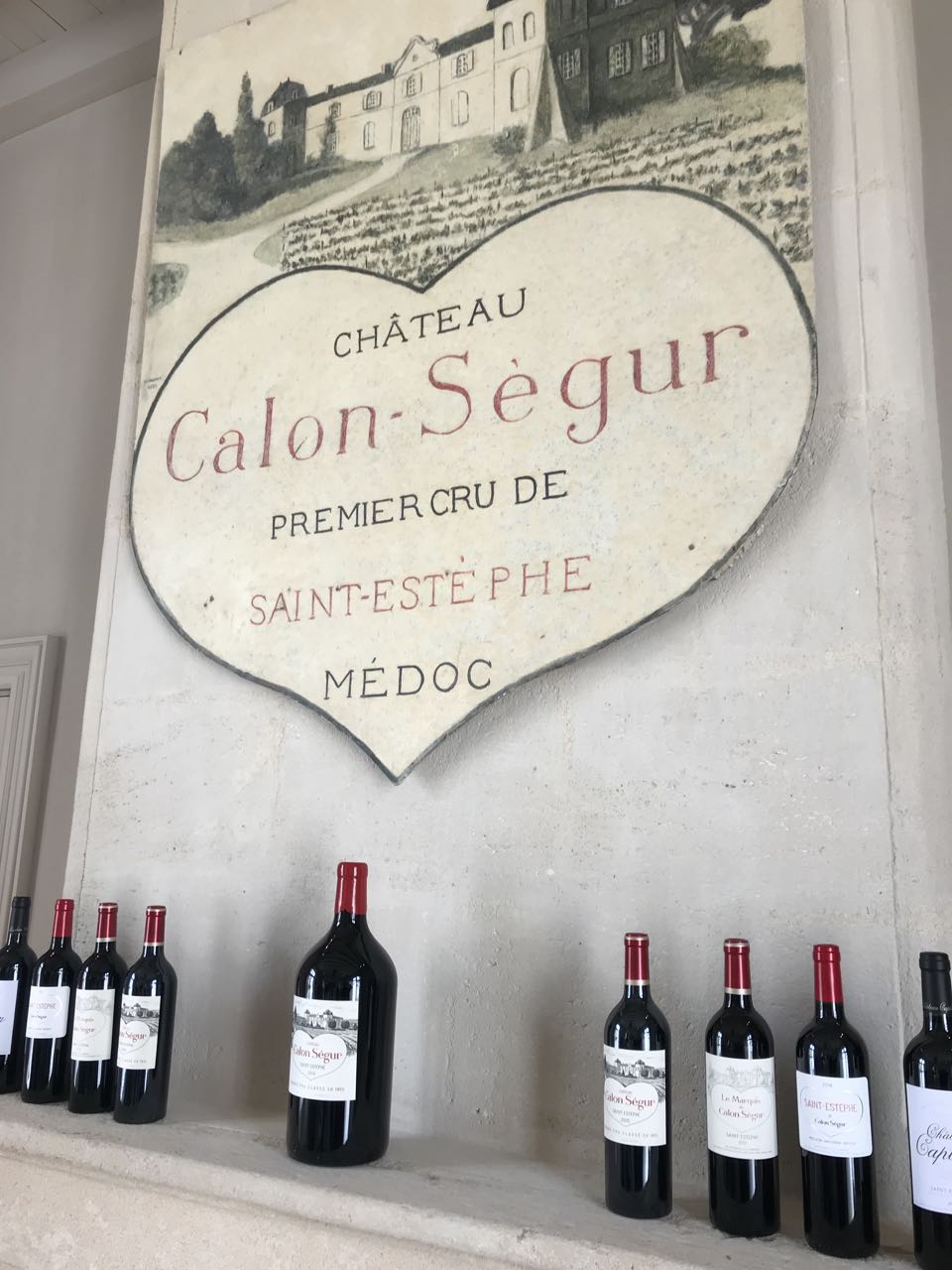
An even bigger heart in 2018
Château Calon Ségur – Bravo to director Laurent Duffau and his team. They are raking in much praise for the “more of everything” wine that is Calon Ségur in 2018. And they made the Liv-Ex Top Ten List from the 2018 barrel tastings survey. I asked how the alcohol level with so many Cabernets could have reached 14.9%. The blend of 65% Cabernet, 17% Merlot, 15% Cabernet Franc and 3% Petit Verdot indeed marks the “first time we arrive at the same level of alcohol for Cabernet Sauvignon as for Merlot” and that is “mainly because of our soils, as the high percentage of clay resulted in a long and regular maturation process,” he explained. “Despite the very dry conditions, our clay helped us to escape any blocking or water stress, and then you have a longer ripening for Cabernet to reach optimal phenolic maturity”. Now the pH is not the highest, at 3.75, encountered in this vintage, and there is just enough acidity to balance things. And, as Bordeaux oenologist Thomas Duclos wrote me in a text message (translated from French): What matters most is not so much the numbers (Château Canon in 2015 had 15.3% alcohol and a pH of 3.70) but the aromatic freshness of the wine. In any case, the barrel sample released pleasing aromas of ripe dark fruit and spice. The finish does have a certain mint like freshness, so there you go! Having muddled through all this, I still felt more attraction to the 2016 from barrel (and it is terrific from bottle, as you can read here). 2018 is a vintage that comes across atypical by its structure. Duffau may reduce the aging in 100% new oak by a couple of months, perhaps to reduce some oak tannin extraction. I give a somewhat broader range for the score, especially to see how it will be from bottle, before scoring, with more precision. 92-96?
Château Cos d’Estournel – With some 2,000 visitors for the main barrel tasting week earlier this month, the most ever at the estate. It was hard to find a parking space! “We saw how hot and dry it was getting and chose to keep leaves on the vines,” explained technical director Dominique Arangoïts. More grapes grown on cooler clay soils than normal were chosen for the first wine in 2018, he confirmed. In terms of winemaking, he fermented at lower temperatures to preserve freshness, so at 27° rather than 30. This wine comes across nicely balanced in terms of freshness indeed, and counts among the very best of the 2018s from barrel. At 14.6% alcohol, a bit lower alcohol than the Montrose, for example, and it seems more classical in style by comparison for the vintage, with more freshness, via a pH of 3.69. It contains a touch more Merlot in the blend this year, at 23% and Cabernet Sauvignon at 74%. The tannic index, at 80, is high enough to warrant a bit less new oak for the aging, at 50% new oak rather than 60%. The higher the alcohol in the wine, the more oak tannin is leached. Deep on the palate, with plenty of tannins indeed: they are present and good for aging. Juicy mid palate sap too, with a red fruit lift on the long finish! 95-97
Château Cos Labory – Really fine nose. Focused, rich, licorice, black fruit, seduction. The palate is also powerful but nuanced with tannins that are rather silky! Sure the finish is a bit closed in, but this is younger than a pup. Give it time to smoothen out in barrel. One of the best Cos Labory barrel samples that I can recall. 91-93+
Dame de Montrose – This second wine of Château Montrose clocks in at 3.7 pH and has 14.8% alcohol. This is actually not the monster I was expecting, and better than the Carruades de Lafite, I would say. This is actually very suave and supple, but the “scale” is there, and some precision, too. There is a sense of alcohol that is undeniable. Going back to the nose and you have more of a rustic aspect on the tannins (after tasting the grand vin). You sense the alcohol more here than you do on the grand vin. But this is still pretty darn tasty. 91-93+
Château Laffitte Carcasset – Coming from a rather large 40-hectares vineyard, this barrel sample exhibits a lovely nose, fresh red fruit, all in finesse, and the palate is refined if a bit tight, but that is of course to be expected. The blend of 50% Cabernet Sauvignon, 47% Merlot and 3% Cabernet Franc is nicely balanced and smooth. Bravo! 90-92+
Château Ormes de Pez – Tasted after the Cos Labory and even more refined, through to the finish, as it displays ripe tannin, excellent black and red fruit, with impressive length. As I confirmed in tasting a couple of vintages from this estate for an article to soon appear in Decanter Magazine, this estate is tried and true for quality. 92-94
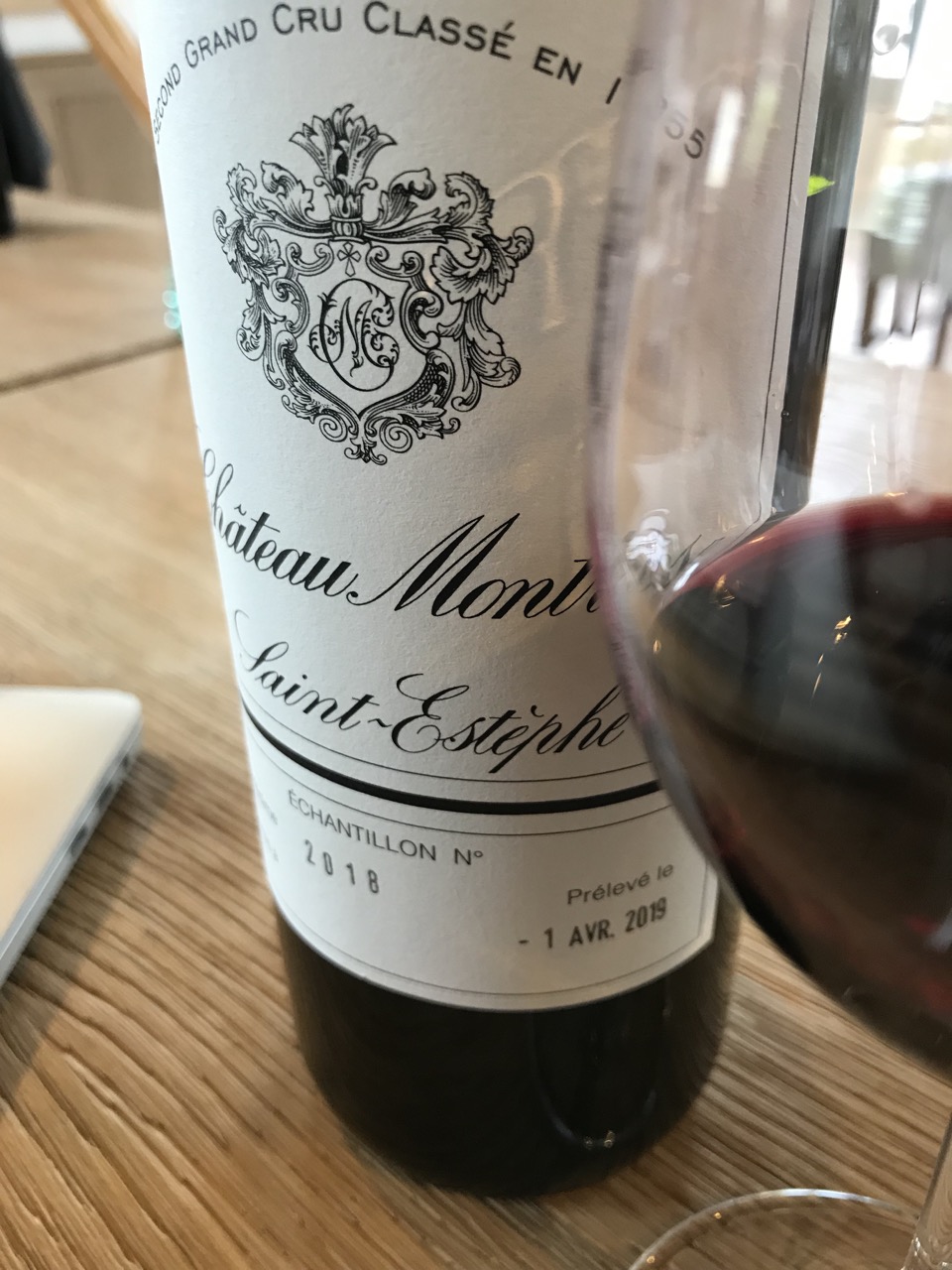
Château Montrose – Mighty Montrose in the making? Certainly this was a vintage of tannin management. The barrel sample is nothing short of amazing in terms of smoothness of tannin and palate density. The in bottle label will indicate 14.5 but in fact the level is 14.8% with a decent level of 3.7 pH. Only 53% of the harvest, which lasted some two weeks, made it into the first wine. I get a fine sense of balance, indeed, but will it have the same energy as in 2016, which has 13.2% alcohol and 3.6 pH. Still, this wine is impressive for both its enveloping palate and downright silky tannins. The polished aspect works so well so that you do get balance. I did get just a touch of warmth on the finish, so, in that sense, I prefer the Cos d’Estournel, if we are comparing the two great “Super Seconds” of Saint Estèphe. “We did not have so much time, even if the weather, was good, but we had to pick quickly, to get fair (enough) degrees,” remarked director Vincent Decup. “The grapes were so very small and yet so very rich, we had to be careful about extraction and this stopped pumping over the must after a certain time; yes, we had to limit extractions so as to avoid too much massive tannins.” Furthermore, the macerations were a bit cooler. For Decup, 2018 is comparable to 2010. I want to err on the side of caution and indicate a wider range of scores, so that this could either be a legendary Montrose or a just a great one. I am already thinking that what 2016 is to 1989, 2018 could be to 1990. Let us see from barrel! 94-98
Pagodes de Cos – What can I say: I really like the clarity and even elegance in this wine. But you do sense a certain ether aspect. Succulent and spicy. “The new facility (constructed in 2008) really helped to manage temperature of grapes better so that we were quickly able to cool down the harvest that came in at 27° Celsius in the afternoon,” explained technical director Dominique Arangoïts. Juicy, and fruit driven, ripe but not overripe in any case. Nice! 92-94
Château de Pez – Yet again more finesse from a top Saint Estèphe wine. It is a bit neck and neck with neighbor Ormes de Pez, which comes across just a bit more complete in its balance, and yet the juicy mid palate here is great, with more freshness on the finish. Maybe an edge to this one? Tasted at the UGCB and at Château Pichon Comtesse a few days later, director Nicolas challenges the notion that it is easier to manage the drought for Saint Estèphe and clay undersoil. “It is not so obvious to obtain silkiness in the palate,” explained the former director of Château Montrose. “If you do not focus a lot on the tannins, you can make monsters”, he explained. He did not craft a monster here, this blend of 49% each of Cabernet Sauvignon and Merlot, plus 1% each of Cabernet Franc and Petit Verdot is the product of a greater focus on more gentle tannin extraction since 2016, he said. The estate will also benefit from new cellar installations to permit parcel by parcel vinification. Clocking in at 14.2% alcohol, the pH is a very healthy 3.65 pH, which may explain the freshness and the finesse. 92-94+
Château Phélan Ségur – While I appreciate the very robust expression from this barrel sample, it does not match the refinement of de Pez or Ormes de Pez. The palate however seems more like Château Lynch Bages, quite powerful indeed in expression. Time in barrel will soften things out, so I give a higher range, with a 94 point potential. 92-94
Château Tronquoy Lalande – Clocking in at 14.7% alcohol but with a rather moderate 3.65 pH, this blend of 51% Merlot, 44% Cabernet Sauvignon, 3% Petit Verdot and 2% Cabernet Franc has features such rich and scrumptious aromas indeed. The palate conveys Black Forest Cake decadence with a touch of warmth on the finish. 91-93
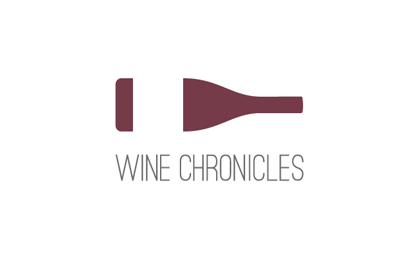 Wine Chronicles
Wine Chronicles
Meyney was not available for tasting ? most of the time seems like a good value for money